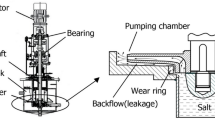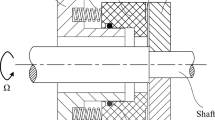Abstract
The stability performance of nuclear pump liquid annular seal was impacted by the parameters including the operating factors and other mechanical factors. The liquid annular which used in nuclear power station was taken as one analysis part, the technical method and model of six degrees of freedom were introduced to explain the dynamic influence on seal during the gravity impact load station. The tested data including liquid seal force and pressure parameter with the change of time was analyzed. The relationship of the factors such as sealing clearance, liquid viscosity, and pumps speed was investigated as well. From the research, it can be found that maximum pressure and seal force was repaid rising and descend quickly subsequently. If pumps sealing clearance was increased, the parameter of sealing force and pressure will be increased as well. If the pump liquid viscosity was increased, the parameter of displacement in axis direction and sealing pressure will be decreased as well. In addition, it can be see that pumps speed factor has no relationship with the parameter of sealing force in gravity direction and sealing pressure.
You have full access to this open access chapter, Download conference paper PDF
Similar content being viewed by others
1 Introduction
The mechanical seals were played a major role in the pumps, especially in the nuclear power station. The annular seal was regarding as the core component, it can eliminate and restrict the leakage. Convention components structure of pumps annual seal were installed in the middle between pumps annular seal parts and inter-stage seal parts [1]. Much studies and tests had been carried and completed in the field of the annular seal parts as deep as hydraulic dynamic analysis. The pumps rotor and seal parts shall suffer huge impact force. Many scholars including Ma Jin Kui, Rao, TICHY, Li Zhen, etc., had studied related test and research about the performance characteristics and condition of seal fluids once suffering transient impact force [2, 3]. For instance, the scholars named Ma Jin Kui had get the relationship and formula on the parameter of thinnest oil film thickness, maximum pressure of film, and axial direction pressure of the pumps under different pulse. The scholars named Rao had get the parameter and curve of rotor in the condition of critical speed by analyzing, and the characteristic of dynamic response in shock condition was summarized as well. The scholars named TICHY has studied deeply on the detail standard how the impact load and load in horizon direction will influence axial trajectory of pumps. The resonance performance of pump annular bearing in various load was studied by Li Zhen. Yan Et team had summarized and build the conclusion and Jeffcott rotor model on fluid analysis of pumps seal component with computer software [4].
To get the further performance and characters of nuclear pumps annual seal [5], this paper will introduce the dynamic response characteristic of pump annular. Factors including seal force, structure clearance, rotor speed, and film pressure will be investigated and discussed.
2 Analysis Element
The common structure of pump liquid annular can see Fig. 21.1, the simplified analysis structure and model can see Fig. 21.2.
The common structure of pump liquid annular [6]
The detail dynamic formula of annular seal is as follows.
The parameter of horizontal acceleration at pump rotor center is expressed as \(\mathop x\limits^{ \cdot \cdot }\); the parameter of vertical acceleration at pump rotor center is expressed as \(\mathop y\limits^{ \cdot \cdot }\); The parameter of sealing force in vertical direction is expressed as Fy; the parameter of impact load in horizontal direction is expressed as Qx; the parameter of impact load in vertical direction is expressed as Qy; the parameter of pump rotor mass and gravitational acceleration are expressed as M and g, respectively. In order to get the further solution for above equation, individual parameter of axial position need to be breakdown as follows:
In above equation, the parameter of time step is expressed as \(\Delta \tau\); the parameter of total time is expressed as \(\tau\). The equation will be periodic and stop till the time is terminated.
3 Calculation and Simulation
From the simulation model build by software, the parameters were set as below (Table 21.1).
From previous investigation, the seal pressure difference is not distinct caused by transient impact load, therefore, this factor was ignored in this paper. The element model of structure and grid detail can be seen in Figs. 21.3 and 21.4. After meshing the model via hexahedron element, there are around 1.7 million elements in totally. With the turbulence simulation condition, setting the wall surface to be adiabatic boundaries [7, 8], after calculation, it can be seen that the inlet and outlet pressure is about 0.18 and 0.12 MPa.
3.1 Influence of the Annular Sealing Radius
To simulate the different radius parameter of sealing including 0.10, 0.20, and 0.30 mm, the analyzed curve and result which can be seen in Figs. 21.5, 21.6, 21.7 and 21.8. From the result, it can be summarized that when radius parameter is larger, the sealing trajectory in axis direction, seal pressure in horizontal direction and gravity direction are rising and maximum sealing pressure in horizontal and gravity direction will be rising as well. In addition, once the radius parameter is larger, the transient impact will be rising simultaneously.
3.2 Influence of the Annular Sealing Fluid Viscosity
In order to get the influence of different fluid viscosities for annular sealing, different fluid viscosity conditions including 0.002, 0.020, and 0.080 Pa s are analyzed by computer; the analyzed curve and result which can Fbe seen in Figs. 21.9, 21.10, 21.11 and 21.12. From the result, it can be summarized that when the fluid viscosity is rising, the displacement value in axial direction will reduce, and the sealing force in horizon direction and gravity direction will reduce as well. In addition, once the radius parameter is larger, the transient impact of force will be rising simultaneously [9].
3.3 Influence of the Annular Sealing Rotor Speed
In order to get the influence of different sealing rotor speeds for annular sealing, different speed conditions including 1500, 3500, and 5500 r/min are analyzed by computer; the analyzed curve and result which can be seen in Figs. 21.13, 21.14, 21.15 and 21.16. From the result, it can be summarized that when the sealing speed is rising, the displacement value in axial direction will be reduced, while the force in gravity direction is not line with the change of speed, it will almost be stable. Meanwhile, the impact value of annular sealing under different speeds seems to have not changed although time is last [10].
4 Conclusion
This paper analyzed and summarized different parameters’ influence on sealing performance and characteristic via simulation, and the parameters are including sealing clearance, fluid viscosity, and sealing rotor speed. From the simulation result, it can be seen that the sealing pressure will rise rapidly and then decline subsequently. When radius parameter is larger, the sealing trajectory in axis direction, seal pressure in horizontal direction and gravity direction are rising and maximum sealing pressure in horizontal and gravity directions will be rising as well. When the fluid viscosity is rising, the displacement value in axial direction will reduce, and the sealing force in horizon direction and gravity direction will reduce as well. Regarding the parameter of rotor speed, the simulation result has proven that there will be no obvious influence on sealing force and pressure.
References
M. Zhang, X.F. Wang, S.L. Xu et al., Numerical simulation of the flow field in circumferential grooved liquid seals. Adv. Mech. Eng. 5, 1–10 (2013)
G. Chochua, T.A. Soulas, Numerical modeling of rotor dynamic coefficients for deliberately roughened stator gas annular seals. J. Tribol. 129(2), 335–341 (2006)
D.W. Childs, The SSME seal test program: leakage tests for smooth, hole-pattern and helically-grooved stators. NASA, Alabama (1986)
L.T. Tam, An iterim report on the calculation method for a multi-dimensional whirling seal. Chamber of North America, Alabama (1986)
Guangdong Nuclear Power Training Centre. 900MW PWR nuclear power plant system and equipment (Atomic Energy Press, Beijing, 2004)
J.F. Dietzen, Calculating rotor dynamic coefficients of seals by finite-difference techniques. J. Tribol. 109(3), 388–394 (1987)
J.F. Gulich, Centrifugal Pumps (Springer, Berlin, 2010)
D.W. Childs, Turbomachinery Rotor Dynamics: Phenomena, Modeling, and Analysis (Springer Press, Texas, 1993)
H.K. Versteeg, W. Malalasekera, An Introduction to Computational Fluid Dynamics (Longman Group Ltd, British, 1995)
C.E. Brennen, A.J. Acosta, Fluid-induced rotor dynamic forces and instabilities. Struct. Control Health Monit. 13(1), 10–26 (2006)
Author information
Authors and Affiliations
Corresponding authors
Editor information
Editors and Affiliations
Rights and permissions
Copyright information
© 2022 The Author(s), under exclusive license to Springer Nature Singapore Pte Ltd.
About this paper
Cite this paper
Song, L., Luo, X., Zhao, C. (2022). Analysis and Performance Evaluation on Mechanical Property of Nuclear Pump Liquid Annular Seals. In: Liu, G., Cen, F. (eds) Advances in Precision Instruments and Optical Engineering. Springer Proceedings in Physics, vol 270. Springer, Singapore. https://doi.org/10.1007/978-981-16-7258-3_21
Download citation
DOI: https://doi.org/10.1007/978-981-16-7258-3_21
Published:
Publisher Name: Springer, Singapore
Print ISBN: 978-981-16-7257-6
Online ISBN: 978-981-16-7258-3
eBook Packages: Physics and AstronomyPhysics and Astronomy (R0)




















